the field artillery journal - Fort Sill - U.S. Army
the field artillery journal - Fort Sill - U.S. Army
the field artillery journal - Fort Sill - U.S. Army
Create successful ePaper yourself
Turn your PDF publications into a flip-book with our unique Google optimized e-Paper software.
Back Toward<br />
Fundamentals<br />
By Maj. A. R. Hercz, FA<br />
With <strong>the</strong> present trend of <strong>artillery</strong> survey away<br />
from plane tabling and inclining more and more to<br />
transit work, it might be appropriate to cast back a glance<br />
at "<strong>the</strong> good old fashioned way" with an eye to salvaging<br />
what is worth while. The principle advantages of <strong>the</strong> allbut-forgotten<br />
plane-table are: that no computations are<br />
necessary in order to get final results, or else that no notes<br />
need be kept for interpretation and replot later; and that a<br />
solution to <strong>the</strong> survey is developed graphically, on <strong>the</strong><br />
ground, where it may be compared with <strong>the</strong> terrain at each<br />
point of progress. Therefore less training is necessary and<br />
fewer mistakes will result than by use of computed survey.<br />
Also many problems (such as resections) may be worked<br />
out graphically with comparative ease, while <strong>the</strong> same<br />
problems solved analytically using transit data are quite<br />
complicated.<br />
While <strong>the</strong> transit is, of course, more accurate, a plane-<br />
Figure 1<br />
204<br />
Figure 2<br />
table survey to an appropriate scale has all <strong>the</strong> accuracy<br />
required for <strong>artillery</strong> purposes (with <strong>the</strong> sole exception of<br />
short-base triangulation).<br />
The chief objections to planetabling are not due so much<br />
to <strong>the</strong> methods as to <strong>the</strong> poor equipment generally used.<br />
Anyone who has stood in <strong>the</strong> wind on Bald Ridge trying to<br />
find <strong>the</strong> Water Tank in Elgin through his open sight while<br />
<strong>the</strong> wind whipped out a tune on <strong>the</strong> front sight hair, or who<br />
tried to unscramble <strong>the</strong> magnetic bearing while his needle<br />
bounced from one side of <strong>the</strong> declinator box to <strong>the</strong> o<strong>the</strong>r,<br />
knows what is meant.<br />
However, with <strong>the</strong> device described below it is believed that<br />
<strong>the</strong> plane table will still be found very useful for many <strong>artillery</strong><br />
surveys, such as <strong>the</strong> position area survey of a battalion.<br />
The only new item required is shown in Figs. 1 and 2. It<br />
simply consists of a brass straight edge near<br />
one end of which a post is rigidly mounted, and<br />
near <strong>the</strong> o<strong>the</strong>r end of which <strong>the</strong>re is a small<br />
knob for a handle. This can be made in any<br />
machine shop from <strong>the</strong> dimensions given in<br />
Fig. 3, which also indicates <strong>the</strong> only critical<br />
machining. A scale along <strong>the</strong> plotting edge is<br />
handy but not necessary.<br />
USE<br />
To use this instrument mount an aiming<br />
circle on <strong>the</strong> post in <strong>the</strong> same way that it fits<br />
onto its regular tripod (Fig. 2). In using this<br />
alidade <strong>the</strong> principles are <strong>the</strong> same as for any<br />
o<strong>the</strong>r type, except for <strong>the</strong> added upper and<br />
lower motions and compass needle. These<br />
allow several short cuts in operation:<br />
A. To set up and orient on a known<br />
visible point:

















